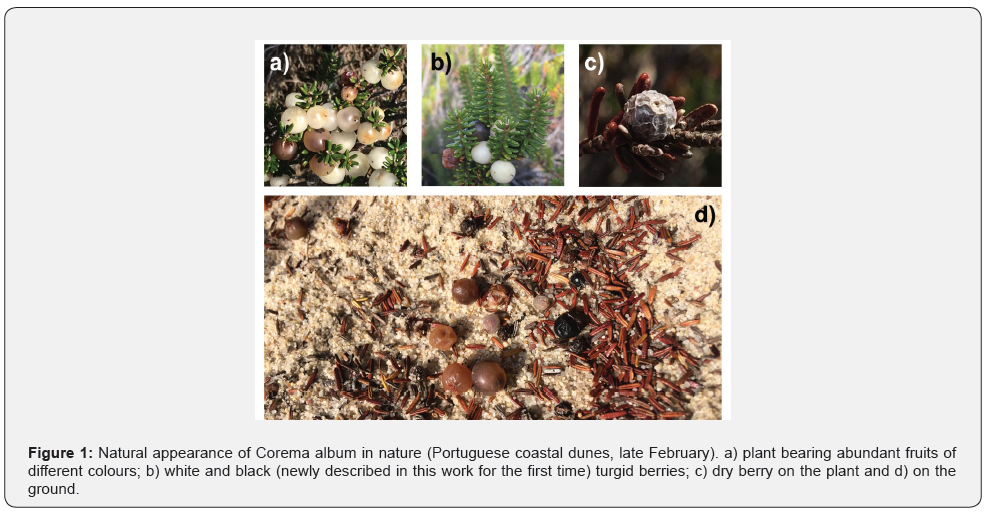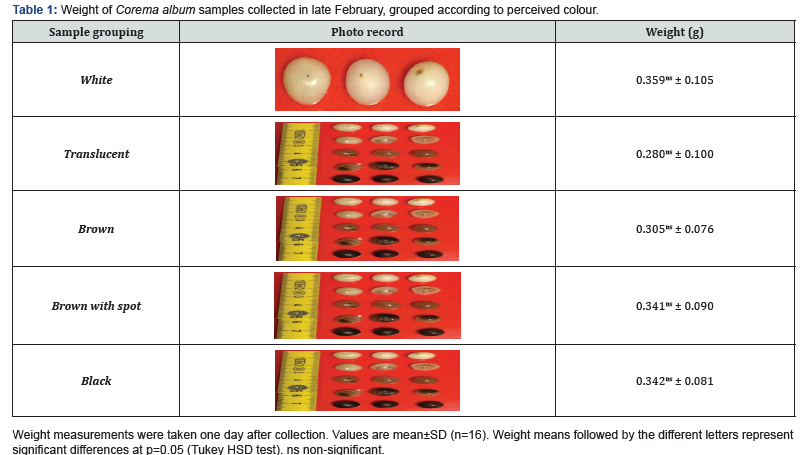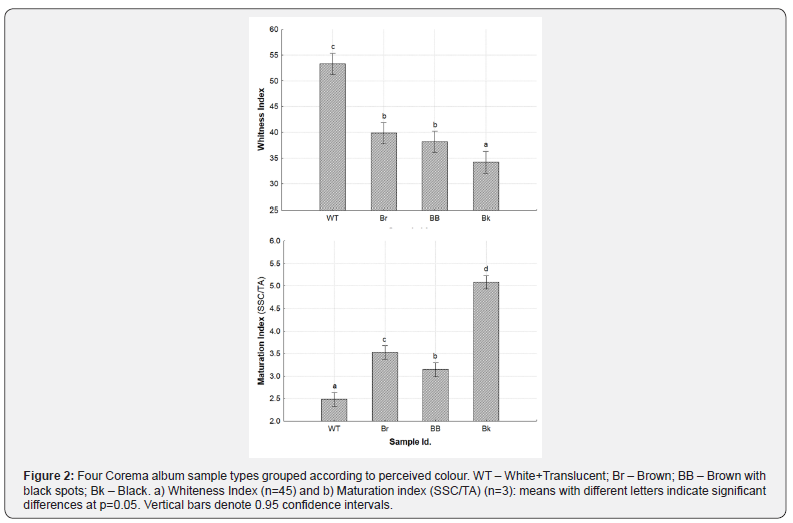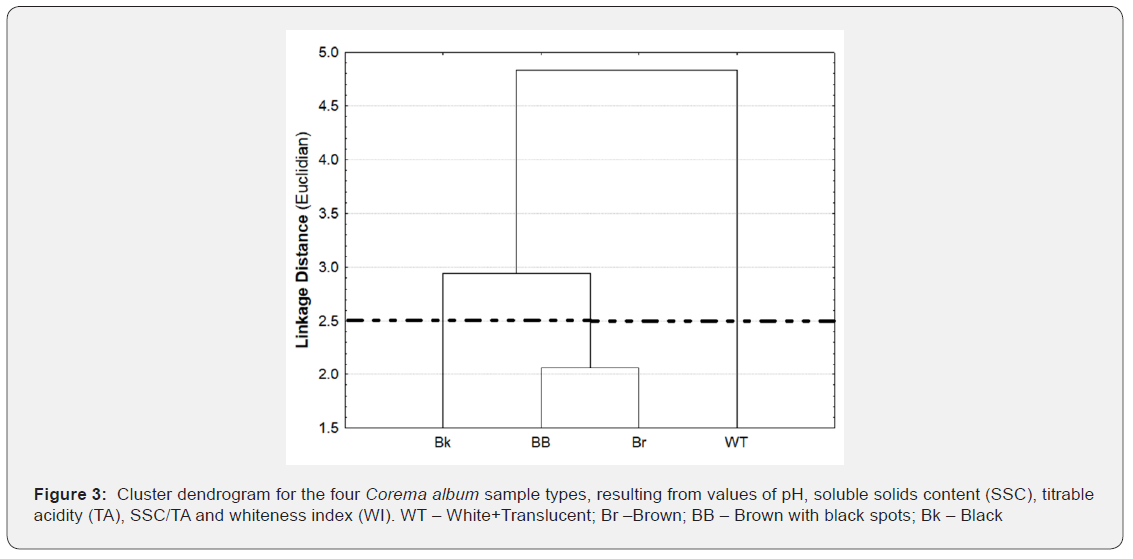Agricultural Research & Technology - Juniper Publishers
Abstract
Increasing interest in Corema album L. is raising due to the appealing white colour and potential health benefits related to its bioactive composition. White fruits production culminates in late August on coastal dunes, but fruits of various colours are present almost till flowering (late February). We undertook a preliminary physical-chemical characterisation (biometric, CIELab colour, pH, soluble solids content and titrable acidity) of a late fruit collection to disentangle maturity progression and to reveal latent qualities for future utilisation. Irrespective of fruit perceived colouration (white, translucent, brown, brown with black spots and black), the characterized high acidity (1-3 g.100 mL-1) is suggestive that over-mature fruits can still be further explored as food additives. Moreover, using a multivariate exploratory technique, we found a clear fruit’s maturation progression from white/translucent to black, a so-far unreported maturity stage. Addressing gaps in plant phenology and fruit’s maturity behaviour is needed before undertaking cultivation.
Keywords: Camarinhas/white crowberry; Maturity indexes; Colour; Phenology
Introduction
Natural resources valorisation and commitment to preserving biodiversity are key issues in sustainable agriculture, to which consumers are getting more sensitive. Identification of local varieties and commercial exploitation of wild and/or underutilized species, as well as improvement of their cultivation, is currently under consideration [1]. Such is also the case of Corema album (L.) D. Don, a white berry wildly growing on the Atlantic coastal areas of Spain and Portugal, with recognized antioxidant properties [2]. C. album is renowned for its white/translucent berries: white or pink-white berry-like drupes with a mildly acid, with a lemony taste [3]. Efforts are in place to test breeding conditions in a view of newly agronomic and market possibilities. The white fruits have been chemically characterized. C. album berry phenolic extracts were found to be rich in hydroxycinnamic acids, and promising results regarding biological effects on the treatment of liver cells were found while related to the improvement of both redox condition and protection against oxidative stress [4]. Andrade and colleagues [5], after providing a physical-chemical characterization of the white fruits, concluded that C. album may be an important source of fibres and sugars. Oliveira and Dale [3] made an excellent resume of the state-of-the-art, describing and listing existing literature on the biogeography, known vegetative characteristics and life cycle, as well as current uses and potential horticultural distribution and production system. C. album could be grown from coastal areas in southern France, around the Mediterranean down to southern Morocco.
There are still gaps in the biology of the species possibly preventing the successful plant breeding and commercialization of the fruits. C. album is a dioecious Ericaceae, i.e. with male and female individuals (few hermaphrodites are also reported). Larrinaga and Guitian [6] tested three fruit traits and they were all found to be related more to among- and within-plant variation, than among-population. When addressing to commercial performances, it is important to consider intrinsic differences of plants, either due to gender- [7] or environmental-related responses [8], since they may be later reflected on the expected productivity. In Portugal, fruits ripen (reaching the intense white colour) earlier at south locations (June and July), or later in northern ones (August to September), and berries are longpersistent on the plant at least till October-December, from known reports. The large period of fruit production may turn into an added economic value. Therefore, we performed a preliminary physical-chemical characterisation of a late collection of berries, also highlighting correlation of perceived colours with maturation stages. In the field, we surveyed plants still bearing fruits when the subsequent flowering stage was starting and, in the laboratory, we evaluated superficial colour and maturity parameters
Material and Methods
Sampling
We collected C. album L. fruits from 25 female plant individuals in a coastal dune system (Pinheiro-da-Cruz, Portugal; 38°14′N, 8°46′W). Berries were collected on the 21st of February 2019: flowering was incipient with individuals bearing flowers, while others were still bearing fruits from the previous season. Samples were grouped accordingly to colour classes defined in the field: white, translucent, brown, brown with black spot, black. Apart from differences in perceived colour, all sampled fresh berries were turgid and round, and all still on the plant at the moment of collection. Also, samples of dry berries were collected from the ground: as for colours, they could be separated into two more categories, black and grey. Samples were transported to the laboratory in ventilated plastic containers and, upon arrival to the laboratory, all samples (fresh and dry berries) were kept under refrigerated conditions (4°±1 °C, Kelvinator 2). One day after collection, 16 berries from each colour group (turgid and dry) were individually weighted, using a professional scale (K2-20, G & G, GmbH, capacity/accuracy 20 g/0.001g). Remaining berries were kept under refrigeration until further analysis. Ten days after collection, two fruit groups (white and translucent) were no longer identifiable based on colour and were, therefore, merged into one group for further analyses. Fresh berries from the four groups (white+translucent [WT], brown [Br], brown with black spot [BB] and black [Bk]) were analysed in triplicate for colour (CIELab) and maturity parameters of pH, titrable acidity (TA, g.100 mL-1) and total soluble content (SSC, %).
CIELab colour
Berries superficial colour was evaluated with a CR 300 Minolta colorimeter (Osaka, Japan) by measuring CIELab parameters (C illuminant, 2nd observer), calibrated using a white tile standard (L* = 97.10; a* = 0.08; b* = 1.80). 45 measurements were made per sample type (one measurement per fruit) and the L*a*b* data was then transformed to chroma (C*) using the expression C = (a*2 + b*2)1/2, to Hue angle (0-360°), obtained by the tan- 1(b*/a*), expressing the characteristic/dominant colour and to the whiteness index score (WI) according to the equation WI = 100 - [(100-L*)2 + a*2 + b*2]1/2 [9].
Maturity parameters: pH, Titrable acidity and Soluble Solids Content
For pH and SSC (%) of freshly prepared juice, we employed a pH meter (Crison Micro pH 2001, Crison Instruments, Spain) and a digital refractometer (DR-A1, ATAGO Co Ltd., Japan), respectively. Titrable acidity (TA) was determined by titrating the freshly prepared juice with 0.1 N NaOH to an endpoint of pH 8.1 using a Mettler Toledo DL21 automatic titrator and expressed as the mass equivalent (g) of citric acid per 100 mL of juice (g.100 mL-1). The maturation index was calculated as the ratio between SSC and TA. The pH, SSC and TA determinations were carried out in 10g triplicates for each sample type and the average values considered.
Statistical Analysis
We applied ANOVA (Statistica™v.8, StatSoft Inc., 2007) on data from the trial, and determined statistically significant differences (p<0.05) between samples (Tukey Honestly Significant Difference - HSD test). We also applied a multivariate exploratory technique, hierarchical cluster, to establish a relationship between colour parameters and fruit maturity indexes. The clustering process involved three steps: data standardization; assessment of a dissimilarity measure among samples; and the use of a grouping technique. Data standardization was done to provide null means and variance equal to one for each sample. The Euclidean distance was used as a dissimilarity distance [10]. Ward’s method was used as the grouping technique [11], which involves an agglomerative clustering algorithm starting at the leaves (n clusters of size 1) to the trunk until all the observations are included into one cluster. That is referenced as most appropriate for quantitative variables.
Results and Discussion
Field observations and fresh weight of samples
In the field, we could identify five groups according to perceived colour and collected photographic records (Table 1 and Figure 1). The majority of plants were carrying berries of different colours, and some were especially rich in the number of berries (Figure 1a). Presence of white fruits at any moment, and even during flowering, was already reported [12,13]. Magalhães [13] indicated brown berries as the complete maturation phase, corresponding to fruit senescence. In literature, black berries were never reported. Berries were mostly still turgid, independently from their colour (Figure 1b); however, some fruits had started wrinkling and interestingly, again independently of colour. It is the first time that turgidity and wrinkling are reported in berries of different colours: it needs to be investigated deeper since this observation is challenging the intuitive expectation of wrinkled fruits corresponding to a later maturity stage.
In previous literature, the weight of white berries was investigated. Differences emerged, but the causes were missing. Considerable variability was found between-sites and within sites by Oliveira & Dale [3]. The average weight of our sample of white berries was similar to that of Andrade et al. [5]. This study also reports weights of berries of different colours (Table 1) and compared the average weight between colour groups. No differences in weight, ranging from 0.280 g to 0.359 g (translucent and white samples, respectively), were found between fresh fruit samples (p>0.05). In the field, we also recorded wrinkled, dry berries with a shape still roundish but irregular (Figure 1c). Dry berries, grey or black, were more frequent on the ground, where they accumulated in natural depressions (Figure 1d). Dry berries weighted markedly less than fresh berries (around 10% fresh weight) and significant differences (p<0.05) were found between the colour groups, with grey lighter than black dry berries (0.028 ±0.008 g vs. 0.035 ±0.006 g).


CIELab colour
As mentioned, the groups previously defined in the field changed after 10 days, and two fruit groups, white and translucent, were merged. Table 2 reports CIELab colour parameters. As expected, significant differences were found regarding berries luminosity values (L*), as this parameter corresponds to lightness and ranges from 0 (darkest black) to 100 (brightest white). The significant differences between all samples (p<0.05) supports the initial classification leading to fruit grouping, with decreasing order of L* values: 53.5>42.1>38.2>34.2 for WT, Br, BB and Bk, respectively. Despite these differences, all samples had positive a* values suggesting that all fruits tend to be to some extent more pinkish/reddish than greenish (negative a* values). No differences were found between Br and BB samples (p>0.05), which indicate that these groups hold similar reddish tones. Both WT and Bk samples had lower, but positive, a* values (p<0.05), related to purer white/black colours. As for the b* values (relating to blue, negative, and yellow, positive), the variability found among samples determined no differences between them (p>0.05), but all are centred on zero. Focusing on white fruits, Andrade et al. [5] found L* values higher than ours (79.8 vs. 53.5), which might be attributed to the fact that WT samples comprised both white and translucent fruits, a condition not reported in the referenced study. Our data do instead agree with their findings as for a* values of white berry fruits (positive, but low a* values), as well as for b* values defined a yellow domain in the white fruits (positive b* values). Finally, we did not spot any difference between sample types (p>0.05) as for chroma values (C*), ranging from 2.2 to 7.5. As for hue angle (°H), only black fruits (Bk sample) were significantly different from other groups (WT, Br and BB samples, p>0.05).


The hue angle of Bk (275.8°) positions these in the zone of blue hues which, considering also the respective a* (1.5) and b* (-1.1) values, characterizes this sample with a dark shade, closest to pure black. Despite no significant differences were found between hue angles of WT, Br and BB samples, probably due to the high variability, respective mean hues set different colour tones for these samples: WT samples, with an 83.2° hue, are characterized in a more lighter yellow zone as previously described by Andrade et al. [5]; whereas Br and BB samples, with hues of 69.7° and 61.3°, respectively, are characterized in a darker brownish zone. Sample whiteness index is shown in Figure 2a, expressing a measure correlated to ratings of white. WT samples have the highest WI values (53.3±3.8), differing significantly from remaining samples (p<0.05) and correlated to the whitish perceived colour. Br and BB samples have similar WI scores (39.8±13. 5 and 38.1±2.0, respectively, p>0.05), but significantly higher than Bk samples (34.2±2.5). Therefore, grading the “amount” of white, samples can be ranked in decreasing WI order as follows: WT>Br=BB>Bk.
Maturity indexes
Table 3 shows the results of maturity parameters, pH, soluble
solids contents (SSC) and titrable acidity (TA). C. album berries
have a sweet-sour or acid taste, making sugar concentration and
pH important parameters for assessing fruits quality and maturity
stage. All fruit samples had low pH values (<3.5 pH units), with
no differences found between WT and Br samples (p>0.05). The
pH range (3.1

As for titrable acidity (TA), highest values (p<0.05) were found in WT samples (∼3%), followed by Br and BB (∼2%, no differences between them) and Bk samples (1.3%). The high acidity previously reported for C. album berries [2,5] was inferred as a quality trait possibly leading to a lack of demand by consumers. Nonetheless, it also represents an opportunity to other paths of commercial valorisation: as a food additive, namely as an acidulant or and acidity regulator, acting as a food preservative agent. The grading of TA, gathered with SSC values, is suggestive of the maturation process, in which WT sample would be near-optimal maturation and Bk samples would be nearing fruits senescence. We assessed the maturation index SSC/TA (Figure 2b), not only as an indicator of maturity itself but also as an indicator of fruit storability and palatability. As expected, an increasing grading was also found: WT>BB>Br>Bk. The increase in the SSC/TA relates to a maturation pattern, where Bk fruit samples can be considered as having the highest maturity among all samples. Clustering analysis allowed to distinguish the attributes of greater relevance in the characterization of the fruit groups, revealing the importance of the correlation between maturity indexes of SSC/TA ratio and pH and total soluble solids, titratable acidity and colour parameters (expressed as WI). Figure 3 shows the dendrogram resulting from hierarchical cluster analysis, based on the maturity indexes and colour parameters. Three distinct sample groups emerge when applying a dissimilarity distance of 2.5 units (Euclidian distance). The first group (from left to right) includes Bk samples, the second group Br and BB samples and a third group composed by WT samples. Sample grouping by clustering confirms the previously mentioned maturation pattern, where fruits colour, SSC and TA define the maturation progression from white/translucent, to brown, to black fruits.
Conclusion
This work contributed two important outcomes concerning the underutilized C. album. The first result regards fruit maturity progression: total soluble solids content (SSC), titrable acidity (TA), the maturation index SSC/TA and clustering analysis, all sustain a precise progression from white/translucent to black, the latter being a maturation stage never described before. The second result regards C. album fruits holding high acidity along the maturation process, suggesting that fruit valorisation could be recommended also beyond commercial maturity and palatability, holding potential as a food additive.
Acknowledgement
Authors C. Alegria, C. Máguas and M. Giovanetti acknowledge financial support from Fundação para a Ciência e Tecnologia (FCT, Portugal), through the strategic project UIDB/00329/2020 granted to the Centre for Ecology, Evolution and Environmental Changes, cE3c, Faculdade de Ciências, Universidade de Lisboa. Authors C. Alegria (SFRH/BPD/126703/2016) and M. Giovanetti (ARIMNET/0005/2016) also acknowledge the financial support from Fundação para a Ciência e a Tecnologia (Portugal). The funding sources had no involvement in study design; in the collection, analysis and interpretation of data; in the writing of the report; and in the decision to submit the article for publication.

To Know more about Agricultural Research & Technology
Click here: https://juniperpublishers.com/artoaj/index.php
Click here: https://juniperpublishers.com/index.php





No comments:
Post a Comment